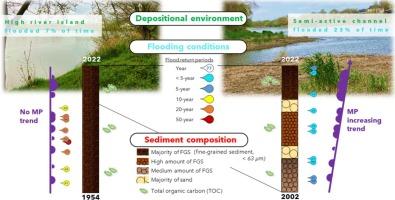20世纪50年代以来河流沉积物中微塑料记录的主要驱动因素:以法国卢瓦尔河为例
IF 8
1区 环境科学与生态学
Q1 ENVIRONMENTAL SCIENCES
引用次数: 0
摘要
微塑料(MPs)经常在河流沉积物中被检测到,但导致其长期存档的过程需要更多的研究。本研究以不同沉积条件的河段为研究对象,探讨了沉积物中MPs的演化过程。两个岩心是在一个高岛上收集的——只在溢岸时期被淹没——在一个半活跃的河道中也在中度水期被淹没。通过μFTIR(微傅里叶变换红外)光谱对沉积物进行了表征(测年、组成、沉降速率),得到了25 ~ 5000 μm的MP浓度、粒径和聚合物类型。2000 ~ 2022年半活性通道岩心中MP浓度的增加与有机质逐渐分选和富集有关。岛屿核心的MP浓度无趋势(1950 -2022年),尽管其对其他颗粒结合污染物的记录能力已得到验证,但这归因于洪水事件驱动的MP输入。综上所述,我们得出的结论是:(1)河流沉积物中的MP有利于高丰度的细粒(<63 μm)和富toc沉积物,但(2)沉积区域决定了洪水频率,(3)大量的MPs在河流中迁移。该研究为研究河流沉积环境中非均质聚磷过程提供了新的视角,对今后的监测研究具有重要意义。这些发现有助于更好地了解河流沉积物的MP污染,并且是沉积物岩心评估的补充步骤,可以及时提供有价值的回顾性污染演变观点。本文章由计算机程序翻译,如有差异,请以英文原文为准。

Main drivers for microplastic records in river sediments since the 1950s: Case study of the Loire river (France)
Microplastics (MPs) are often detected in river sediment, but the processes that lead to their long-term archiving need more investigation. In this study, the evolution of MPs buried in sediments was explored in a river segment with a diversity of deposition conditions. Two cores were collected on a high island -flooded only during overbank episodes- and in a semi-active channel also flooded during moderate-water periods. After a characterisation of sediment (dating, composition, sedimentation rate), 25–5000 μm MP concentrations, size and polymer types were obtained through μFTIR (micro Fourier-transform infrared) spectroscopy. The increase in MP concentrations in the semi-active channel core (2000s-2022) was found to be related to the gradual grain sorting and enrichment in organic content. The no-trend in MP concentrations in the island core (1950s-2022), despite its verified recording capacity for other particle-bound contaminants, was attributed to flood event-driven MP inputs. To sum up, we concluded that (i) MP archiving in riverine sediments was favoured by a high abundance of fine-grained (<63 μm) and TOC-rich sediment, but that (ii) it was conditioned to depositional area determining flooding frequency, and (iii) large quantities of MPs transiting in the river. This study provides a novel insight on heterogeneous MP accumulation processes in riverine depositional environments, which is key for future monitoring studies. These findings participate to a better understanding of MP contamination of river sediments and are a supplementary step in the assessment of sediment cores to give valuable retrospective views on pollution evolution in time.
求助全文
通过发布文献求助,成功后即可免费获取论文全文。
去求助
来源期刊

Science of the Total Environment
环境科学-环境科学
CiteScore
17.60
自引率
10.20%
发文量
8726
审稿时长
2.4 months
期刊介绍:
The Science of the Total Environment is an international journal dedicated to scientific research on the environment and its interaction with humanity. It covers a wide range of disciplines and seeks to publish innovative, hypothesis-driven, and impactful research that explores the entire environment, including the atmosphere, lithosphere, hydrosphere, biosphere, and anthroposphere.
The journal's updated Aims & Scope emphasizes the importance of interdisciplinary environmental research with broad impact. Priority is given to studies that advance fundamental understanding and explore the interconnectedness of multiple environmental spheres. Field studies are preferred, while laboratory experiments must demonstrate significant methodological advancements or mechanistic insights with direct relevance to the environment.
 求助内容:
求助内容: 应助结果提醒方式:
应助结果提醒方式:


